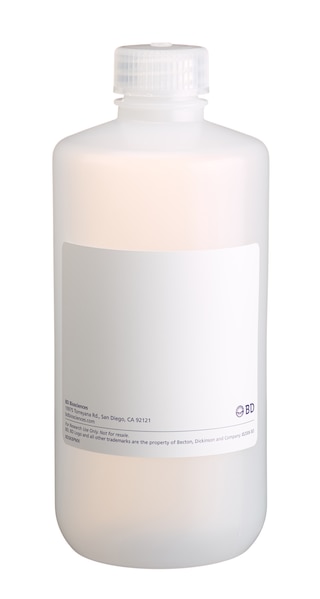Old Browser
This page has been recently translated and is available in French now.
Looks like you're visiting us from {countryName}.
Would you like to stay on the current country site or be switched to your country?


.png)

Analysis of Ezrin (pY353) in human chronic myelogenous leukemia. Serum-starved K-562 cells (ATCC CCL-243) were either treated with 1 mM Pervanadate (Sigma Cat. No. S6508) at 37°C for 20 minutes (shaded histogram) or untreated (open histogram). The cells were fixed (BD Cytofix™ buffer, Cat. No. 554655) for 10 minutes at 37°C, then permeabilized (BD Phosflow™ Perm Buffer III, Cat. No. 558050) on ice for at least 30 minutes, and then stained with Alexa Fluor® 488 Mouse anti-Ezrin (pY353, Cat. No. 558627). Flow cytometry was performed on a BD FACSCalibur™ flow cytometry system.
.png)

BD™ Phosflow Alexa Fluor® 488 Mouse anti-Ezrin (pY353)
.png)
Regulatory Status Legend
Any use of products other than the permitted use without the express written authorization of Becton, Dickinson and Company is strictly prohibited.
Preparation And Storage
Product Notices
- This reagent has been pre-diluted for use at the recommended Volume per Test. We typically use 1 × 10^6 cells in a 100-µl experimental sample (a test).
- Source of all serum proteins is from USDA inspected abattoirs located in the United States.
- Caution: Sodium azide yields highly toxic hydrazoic acid under acidic conditions. Dilute azide compounds in running water before discarding to avoid accumulation of potentially explosive deposits in plumbing.
- Alexa Fluor® 488 fluorochrome emission is collected at the same instrument settings as for fluorescein isothiocyanate (FITC).
- For fluorochrome spectra and suitable instrument settings, please refer to our Multicolor Flow Cytometry web page at www.bdbiosciences.com/colors.
- The Alexa Fluor®, Pacific Blue™, and Cascade Blue® dye antibody conjugates in this product are sold under license from Molecular Probes, Inc. for research use only, excluding use in combination with microarrays, or as analyte specific reagents. The Alexa Fluor® dyes (except for Alexa Fluor® 430), Pacific Blue™ dye, and Cascade Blue® dye are covered by pending and issued patents.
- Alexa Fluor® is a registered trademark of Molecular Probes, Inc., Eugene, OR.
- Please refer to www.bdbiosciences.com/us/s/resources for technical protocols.
Companion Products


Ezrin is a member of the ERM (ezrin-radixin-moesin) family of proteins that function as crosslinkers between the actin cytoskeleton and the plasma membrane. Ezrin is a substrate for the tyrosine kinase epidermal (EGF) and hepatocyte growth factor (HGF) receptors. Upon EGF or HGF stimulation, ezrin is phosphorylated on tyrosine 353 (Y353), which is required for its interaction with phosphatidylinositol 3 kinase p85 subunit and activation of Akt.
The I66-386 monoclonal antibody recognizes the phosphorylated Y353 of human ezrin.
Development References (2)
-
Gautreau A, Poullet P, Louvard D, Arpin M. Ezrin, a plasma membrane–microfilament linker, signals cell survival through the phosphatidylinositol 3-kinase/Akt pathway. Proc Natl Acad Sci U S A. 1999; 96:7300-7305. (Biology). View Reference
-
Krieg J, Hunter T. Identification of the two major epidermal growth factor-induced tyrosine phosphorylation sites in the microvillar core protein ezrin. J Biol Chem. 1992; 267(27):19258-19265. (Biology).
Please refer to Support Documents for Quality Certificates
Global - Refer to manufacturer's instructions for use and related User Manuals and Technical data sheets before using this products as described
Comparisons, where applicable, are made against older BD Technology, manual methods or are general performance claims. Comparisons are not made against non-BD technologies, unless otherwise noted.
For Research Use Only. Not for use in diagnostic or therapeutic procedures.
Report a Site Issue
This form is intended to help us improve our website experience. For other support, please visit our Contact Us page.